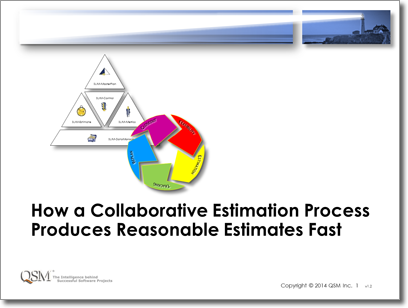
QSM's recent webinar, How a Collaborative Estimation Process Produces Realistic Estimates Fast, presented by Laura Zuber, sparked a lively Q&A session from our audience. Here are the highlights:
Q: How do I know which template to use when creating a new estimate in SLIM-WebServices?
A: That’s a good question. Your back office administrator configures templates to map to your software development lifecycle, your standard processes and different project types. The back office person can provide detailed descriptions and key information that are viewable from the Feasibility Wizard so you know which one to select.
Q: What makes a project assessed as conservative or risky?
A: The project’s desired outcome is compared against the recommended estimate based on the historical trends. The recommended estimate is what a typical project would require in time and effort. If your project proposes too little effort or too little time, it will be “risky,” and usually having more of both of those resources is “conservative.” These ratings do not take into account your manager’s risk tolerance, however, so “conservative” might actually turn out to be “risky” for you. It’s the starting point for your risk assessment analysis. The benefit is in seeing where your estimate is different and whether or not that will be acceptable from a business standpoint.
Q: Can we use custom trendlines or it is only industry standards?
A: Absolutely. That’s another role that the back office administrator performs in addition to authoring templates and creating what we call “configuration sets” which are just separate components of templates that you can use and mix and match individually. Uploading trends is a very important part of that. We always encourage customers to take advantage of their own history and that’s in the form of custom trends.
Q: How do I know when to advance an estimate to a different stage?
A: Primarily the decision is tied to your project estimation and approval process, so that may have to do with when you are able to pass through certain gates within your organization of approval. It’s also driven by the amount of data you have available. The Feasibility Estimate only considers a high level of scope, time and the various cost targets. When you’ve completed some requirements and design work and can provide detailed sizing estimates and want to explore a range of alternative scenarios, then you need to advance to the Estimation stage. Advancing to Closeout allows you to quickly capture the final actuals once a project is completed.
Q: Is SLIM-WebServices training available for end users?
A: Yes, SLIM-WebServices training is available for end users and we cover not only just the tool but the estimation process as well, so you don’t need any previous experience.
Q: Do I have to use SLIM Suite to use the online application?
A: SLIM-WebServices is a standalone product and it can be used with the desktop tools. It’s just a matter of if you want to use the advanced features or not. The trends and templates and project configurations can be set up for you.
Q: Who hosts SLIM-WebServices? Can we host that ourselves?
A: There are two options. It depends again on the organization and what their requirements are and what their desires are. SLIM-WebServices can be self-hosted or QSM-hosted.
Q: Where does the QSM Database come from?
A: The QSM Database, from which the trends are based, comes from years and years of working with customers and getting completed projects. The database has recently been updated in 2013. It’s updated about every 2-3 years.
Q: Can you set SLIM-WebServices up for any lifecycle?
A: Absolutely. That’s again a function of the back office person who understands how to map the SLIM lifecycle phases to any development methodology. SLIM is quite flexible. We simply need to look at a completed project from your organization and find out to what extent do you spend time in Requirements and Design, Coding and Testing, how those relate to one another, and those are configured within the templates.
Q: Is the difference between SLIM-WebServices and the desktop version the amount of features and licensing?
A: That is a good starting point. Yes, there is a lighter set of features, if you will. The advanced estimation features are in SLIM-Estimate. SLIM-WebServices is designed to have a variety of stakeholders and a variety of estimation process and contribution to be able to do it, so it’s been simplified. SLIM-WebServices has the added services of the Portfolio and Benchmarking that are different from SLIM-Estimate, so it addresses the managerial needs of folks higher up in the organization and lets them look across several projects, see how they relate to one another, and when the advanced features are needed then they’re there.
Q: Does SLIM-WebServices use the desktop version’s PI or can you configure that in WebServices?
A: It uses a Productivity Index through the trends, so the QSM trends would be available and you could use those Productivity Indexes based on application type. The other way to provide your own Productivity Index is through creating your custom trends. That’s done with our SLIM-Metrics tool. A lot of times if you don’t have that tool, then we’ll be glad as a support group to help you accomplish that goal.
Q: Can other projects besides software development be estimated in SLIM-WebServices?
A: Yes. More and more, we are working with customers that do a variety of system development, maybe different kinds of projects all by themselves or maybe a large effort that has some software, some hardware. We can model infrastructure projects. SLIM’s model, because of the Rayleigh Curve, accommodates an activity that’s a knowledge-based acquisition and it follows an engineering-type lifecycle. Any project that has a size to it, some sort of scope that we can count, it has to go through requirements, design, build, test, and deliver, SLIM can accommodate.
